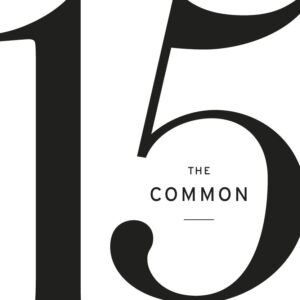
The Reading Life is a special 15th-anniversary essay series reflecting on close reading and re-reading, written by The Common’s Editorial Board.
“Always do what you are afraid to do.”
―Ralph Waldo Emerson
In a letter of February 20, 1997, to a humorist, Oliver Sacks says that one of his favorite words is APOCOPE. “I love its sound, its explosiveness (as do some of my Tourettic friends—for whom it becomes a 4-syllable verbal tic which can be impacted or imploded into a tenth of a second) and the fact that it compresses 4 vowels and 4 syllables into a mere seven letters.” This is the type of response I adore: succinct, passionate, informed, all around a single, transient word. The quote appears in Dr. Sacks’ Letters (Knopf, 2024, 726 pages), edited by his long-time assistant and researcher Kate Edgar. Notice the length of the volume: it is massive, even though, as Edgar mentions, it only comprises about a tenth of all of the letters Dr. Sacks wrote; he was an inveterate, compulsive logophile who wrote nonstop on napkins, pads, notebooks, and anything else within reach. (W. H. Auden, an early champion and long-time friend of Sacks, addressed him in print with the honorific “Dr.”; I gladly follow it here.)
London-born Oliver Sacks moved to Canada in 1960. A year later, he settled in San Francisco to do an internship at Mt. Zion Hospital and then a residency in neuropathology at UCLA. At first he was lonely and disoriented in this country and would spend hours pumping iron at the gym. Gradually he became part of the gay scene in San Franciso and, in search of freedom, motorcycled to distant places. It was then that he experimented with recreational drugs. He wrote about it profusely. In one essay, he talked of reading 19th-century migraine doctor Edward Liveing while using amphetamines. A few years later, he moved to New York to become an instructor, and then a professor, at Yeshiva University’s Albert Einstein College of Medicine, where he worked until 2007. After that, he had stints at New York University and Columbia.
If he had a scientific mind, he also had a fretful, adventurous spirit. He was convinced, as his letters attest time and again, that every experience, regardless of how mysterious it might be, ought to be described in words. He loved to take chances, even if they led to a dead end. A journalist once asked Dr. Sacks about risk-taking. In his answer, Dr. Sacks says he is unsure how to answer “for I regard risk as an essential part of life—at least, of a life which seeks adventure, novelty, uncertainty, surprise, or at least permits these; and a life without these is no life at all.” He adds: “Risk has to accompany every wish, expectation, hope, desire; every promise, every trust; and, for that matter, every hypothesis, every theory; to say nothing of every relation(ship).” Every single word in this statement feels as if I could have written it myself. To test oneself all the time is to know one’s true worth.
An avid letter writer as well, I was once, briefly, one of Dr. Sacks’ correspondents. A few years after my arrival to New York in 1987, I wrote to him, out of the blue. I had just finished reading The Man Who Mistook His Wife for a Hat. I commented on how the case studies assembled in it seemed to me to be prime examples of how the American medical profession approached the mind, which was radically different from Mexico, my home country, where neurologically divergent individuals were less prone to be isolated in hospitals. I wasn’t expecting an answer, but one arrived promptly. It was charming and generous; his empathy registered right away. He mailed me an inscribed Spanish translation of the book. Sometime later, when a weekly Madrid magazine that had heard about our acquaintance asked for a conversation, I visited him at his home in City Island. It was a memorable evening: we talked about Leibnitz and Hume, about Giordano Bruno, Van Gogh, Piranesi and Borges, about Soviet neuropsychologist Alexander Luria’s The Man with a Shattered World: The History of a Brain Wound and British historian Frances A. Yates’ The Art of Memory. (My letters to Dr. Sacks are in my personal archive at the University of Pennsylvania.)
Over the years, he and I saw each other again, albeit briefly and not often. Still, I admired him thoroughly and remained a loyal reader. He managed to give conditions like Parkinson’s and Tourette’s a human face at a time when patients had been turned into sheer statistics. He was a superb scientific writer because he never lost sight of human idiosyncrasy, in a way that reminds me of the calibrated pens of Darwin, William James, Freud, and Stephen Hawking. When Dr. Sacks died, in 2015, I felt a profound sadness.
There is an unavoidable degree of voyeurism when we read other people’s personal letters. These artifacts are confidential, meant for a specific addressee, not us. I adore the passionate, 12th-century letters of Abelard and Heloise because they allow me a glimpse into the soul of tormented lovers, knowing that it will all end up in disaster. I’ve also been swept away by the exchanges between Catherine the Great and Voltaire; he was an intellectual powerhouse and she, as a leader of Russia, wanted to change the perception of her country as backward. More recently, we have the more-than-four-decade-long connections between Johannes Brahms and Clara Schuman, which are as much about love as they are about the classical music scene in the second half of the 19th century. The collection of Dr. Sacks’ letters does not include the missives of his interlocutors (such wouldn’t fit between hardcovers!). Still, the sense of a conversation is embedded.
Hundreds of people wrote to Dr. Sacks. He often described the size of the mail pile that arrived every day as portentous. He read it all and, to the degree that energy and time allowed, responded with undivided attention. As in my case, he accompanied his responses with a copy of his books. The addressees range from his family and relatives (his mother sat Shiva when she learned he was gay), to friends, acquaintances, colleagues and editors, from W. H. Auden to Jerome Bruner, Antonio Damasio, Brian Friel, Jane Goodall, Stephen Jay Gould, Thom Gunn, Bill Hayes, Frank Kermode, Alexander Luria, Jonathan Miller, Harold Pinter, David Remnick, Robert B. Silvers, Susan Sontag, and Lawrence Weschler. The letters might go on for 8 to 10 printed pages. They are extraordinarily detailed, quoting (often from memory) from poems, scientific papers and philosophical disquisitions by Spinoza, Hume, Darwin, Schopenhauer, Bertrand Russell, and Dostoyevsky.
The letters were written over a period of forty-five years, from 1960, when Dr. Sacks was 27 years old, to shortly before his death, in 2015. Edgar is right when she says in the preface that the letters “are full of contradictions: they are ferocious, tender, observant. They betray a degree of self-absorption—the kind many of us might evince in adolescence—but more usually show a concern and generosity, especially for people at the margins of society: young people, old people, incarcerated people, and, of course, patients living with unusual syndromes of maladies.” All that is in them and more: a doctor provoked to record, as accurately yet floridly as possible, every single thought, every emotion he experienced.
It might appear facetious to describe this book as Dr. Sacks’ best, but it is. It is utterly confessional and distills authenticity and wrenching compassion, and, as such, it is unlike any other. No sentence appears rushed, even though Dr. Sacks apologizes for the limited time he has to fulfill the letter-writing task. He uses dashes, italics, semicolons, parenthetical sentences with gusto. He even includes an occasional footnote. All of the letters come across as composed by a stylistically endowed author whose scientific mind is sharp yet kindhearted. And yet for decades he was afraid of loving someone romantically. In these letters, uniformly delivered in a style at once candid and meditative, precise yet unafraid of a stream-of-consciousness mode (which might explain a somewhat off-kilter tone), the reader is allowed a privileged view—one not truly meant for us—of how his mind and his heart clashed all the time. His dreams and sorrows, his excesses and insecurities are all mapped out here. (These are also featured the various installments of the autobiography Dr. Sacks produced in the latter period of his career, where he explored his Jewish upbringing in London in the 1950s, his homosexuality, and his use of hallucinogens.)
Early in his career, Dr. Sacks was ostracized by academia. He was accused of being obsessed with freaks whose case studies would be thinly-veiled circus performances. Unfrazzled, he sought his own path, the Frostian road less taken: writing for a large public. Dr. Sacks was bright and charismatic and full of energy but narcissistic. In most, if not all of, his pieces, he appears as the observer yet is actually the protagonist: he sorts out neurological riddles, a Sherlock Holmes-like detective using deductive reason to bring order into chaos. This approach is tangible throughout his career, starting with Awakenings, where he chronicled the reaction to L-DOPA of patients who in the 1920s had been diagnosed with encephalitis lethargica epidemic and were vegetating at the Beth Abraham Hospital in the Bronx.
Dr. Sacks himself was a neurotic, as I am (and maybe all of us are). In a letter of May 26, 2005, to psychologist Görel Kristina Näslund, Dr. Sacks says that he suffers from “topognosia”: “I constantly get lost, unless I follow fixed routes, and have detailed verbal directions. I do not consistently recognize my own street or the building I live in, let alone other people’s streets. I have repeated illusions of recognition—déjà vu and jamais vu, both false.” And then he talks about his “significant problems with self-recognition. On several occasions I have almost collided with a large, bearded man, started to apologize, and realized I had run into a mirror. The opposite has also occurred. Once, when having coffee outside a restaurant, I turned to my reflection in the window, and started to smooth my beard, then realized that my “reflection” was doing nothing of the sort, but staring at me in wonder—this was a bearded man inside the restaurant, whom I had mistaken for my own reflection.” And he concludes: “So the author of The Man Who… has some personal experience of what he writes about!”
Getting lost is one of my miseries. Maybe not a misery but a hobby, since I actually like getting lost because it emphasizes my vulnerability. Whenever I’m in a city, even Mexico or New York, which I know like the back (?) of my hand, I get lost. I don’t confuse myself with others, like Dr. Sacks did, but I constantly misremember names and faces. I can sometimes be overwhelmed after seeing someone who inexplicably looks fifteen or twenty years older, as if I had forgotten that time, that implacable force, never leaves us alone. Also like Sacks, I also have a peculiar memory: I remember extended passages from texts and am able to place events in their historical context but might not be able to tell you what I had for lunch yesterday. What strike me the most in Dr. Sacks’ letters is the humility with which he recognizes his limitations. No matter his achievements, he felt as if the tasks ahead were the most important ones, not those behind, and that he might not be fully equipped for them. He was gullible and overly trusting.
On November 14, 2006, a woman referred to simply as Wendy (her last name is omitted for privacy), who was part of a number of residential therapeutic communities for people with severe mental conditions like schizophrenia and bipolar disorder, asks Dr. Sacks: “Why, if symptoms of untreated mental illness are so maladaptive (and too often socially stigmatized), has it survived the evolutionary cutting-floor, so to speak? Am I just a mistake that somehow survived evolution’s ax?” Dr. Sacks’ reply is an example of his empathy. “I don’t know, as a start, how much one can talk about genetic/evolutionary “mistakes,” for while there is natural selection there is no “purpose” (and perhaps no “progress”) in Nature. More to the point, things are very complex, and there can be unexpected spin-offs in both directions, all directions. Sickle-cell anemia is a fatal disease, but sickle-cell trait (to cite a famous example) confers resistance to malaria. (I want to avoid a dramatic way of putting this, like “Thousands die that millions may live”—for there is no “that” in Nature.)”
And then Dr. Sacks hits the nail on the head: “What seems to me less stressed, and most in need of stressing, is that you are an individual—unique—with gifts and genes which no one else in the world exactly duplicates—and that means you have a true place and role in evolution, and in the present. That you have bipolar disorder, in a sense are bipolar, does not begin to encompass the whole of you—it is a what, while you are you.”
Upon reading Dr. Sacks’ letters, I thought that I am—just like others—a fluke, maybe even a mistake. Why have I survived, even thrived? Yet I’m fascinated by mistakes and, honestly, nearly apathetic to normality. What appeals to me are complications, deviances from the norm. Yes, the universe has no purpose. I too doubt there is progress. Are we better off with vaccines? No doubt, yet vaccines are viciously attacked these days, under unwarranted suspicion. Is the iPhone a sign of technological progress? No doubt again, but also of regression, as more people focus their sole attention in it rather than on the splendors of the world outside.
By the way, the definition of APOCOPE, according to Merriam Webster, is “the loss of one or more sounds or letters at the end of a word (as in sing from Old English singan). The attention that Dr. Sacks pays to these losses becomes a gain. He is right: each of us is an individual, with a distinct DNA. Our passage through the universe is a product of chance but we cannot leave up to chance the opportunity of making sense of why we are here. Indeed, the here is just a transitory explosion of consciousness. Leaving behind, in letters and other writing artifacts, the ideas that crossed our minds, the ironies we lived, the dreams we were visited by, is a way to confirm that a day, no matter how anodyne, never goes to waste.
Ilan Stavans is Lewis-Sebring Professor of Humanities, Latin American, and Latino Culture at Amherst College, the publisher of Restless Books, and a consultant to the Oxford English Dictionary. His latest book is Conversations on Dictionaries: The Universe in a Book. Due out next year are A National Wrestles With God: American Prophets, Philosophers, and Firebrands, and Fictional Translations: Poems.




